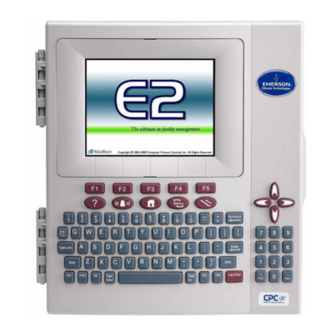
Emerson E2 User Manual
Optimum refrigeration control
Hide thumbs
Also See for E2:
- Installation and operation manual (283 pages) ,
- User manual (34 pages) ,
- Manual (21 pages)
Summary of Contents for Emerson E2
- Page 1 OPTIMUM REFRIGERATION CONTROL WITH E2™ Abtar Singh, Ph.D. Emerson Climate Technologies 1640 Airport Rd. Suite 105 Kennesaw, GA 30144...
- Page 2 This article discusses the control of modern supermarket refrigeration systems using state of the art digital refrigeration controllers manufactured and marketed by Computer Process Controls (CPC), under the “E2” name. This family of refrigeration controllers was designed to provide precise refrigerated product temperature control while minimizing refrigeration system energy and maintenance expenses.
- Page 3 E2 refrigeration system controllers. Before getting into the specific refrigeration control strategies and methodologies included within the E2, it is important to first offer a general description of the parameters that effect energy consumption in a refrigeration systems.
- Page 4 The compressor power required to cool any refrigerated fixture or space can be represented using the following equation: ⎡ α ⎤ − ⎛ ⎞ α α ⎢ ⎥ ⎜ ⎜ ⎟ ⎟ ⋅ ⋅ ⋅ ⋅ − ………………………………………………………………………….(1) ⎢ ⎥ α...
- Page 5 extended defrost. Additional refrigeration energy then has to be expended to remove this extra heat. • Reduce return gas temperature: Based on equation (1), lower suction return gas temperature results in higher density gas and hence lower compressor power. Too high a return gas superheat is therefore as bad as too low a return gas superheat.
- Page 6 Having reviewed the parameters that affect compressor power and system efficiency, we can now explain how E2 controllers are designed to apply these basic principles to refrigeration systems in order to minimize refrigeration system power consumption.
- Page 7 required condenser fan power. Table 3 shows the energy saving that can be achieved by utilizing TD-based floating condensing pressure. Table 3: Effect of condenser control method on total annual energy usage. The first column shows the total (compressor + condenser fan) annual kW (comp.
- Page 8 The application of variable speed drives (VSDs) to condenser fans and compressors motors, controlled using proprietary E2 VSD algorithms, can eliminate these capacity matching problems, and save additional energy as well.
- Page 9 ESRs allows the refrigeration system to deliver the exact temperature required by every fixture group under all load and system conditions, at the same time the E2 directly controls compressor to maintain suction pressures at the highest level possible while satisfying the pressure requirements of all the ESRs.
- Page 10 E2 via network or dialup connection and simply changing setpoints in the E2 controller. A meat case that has held red meat requiring a 32 degF fixture temperature that is then reset with smoked pork products requiring 36 degF, can have its operating temperature adjusted easily and remotely without the expense of a service technician visit.
- Page 11 ESR is in this state and the suction pressure of compressor(s) serving it can be floated further upward. In summary, E2 floating suction pressure control coupled with ESR fixture temperature control provides the following benefits over conventional EPR control: •...
- Page 12 Conventional control keeps the anti-condensate heater 100% on all the time, whereas, control via the E2 controller can cycle the heater depending on the dew-point temperatures in the store. Page 11 of 15...
- Page 13 Figure 4. Anti-Condensate Heater Power Comparison –Fixed Vs. E2 FIELD TEST In order to quantify and understand the value of E2 controller in a supermarket application, a field test was conducted. Two identical stores located within a few miles of one another were selected.
- Page 14 E2 Total Store Energy: 883465 kWh Non-E2 Total Energy: 1070241 kWh Diff (E2/Non-E2) -17.45% Condenser Rack Power Total Power (kWh) (kWh) (kWh) E2 Store 48891 338135 387026 Rack A Non-E2 Store 76754 421073 497827 Diff (E2 vs Non-E2) -36.3% -19.7% -22.3%...
- Page 15 Table 5: Summary of key data from field test • Refrigeration system suction pressures were higher in the E2 store, resulting in lower refrigeration system energy usage. This was directly attributable to the use of ESRs and the resulting automatic suction pressure adjustments over the course of the year and load conditions.
- Page 16 CPC Peripherals Installation and Operation, 026-1701 Rev 0 01-05-98, Computer Process Controls Inc., 1640, Airport Rd. Suite 105, Kennesaw, GA, 1998. E2 RX Refrigeration Controller Installation and Operation Manual, 026-1610 Rev 1 5-05- 03, Computer Process Controls Inc., 1640, Airport Rd. Suite 105, Kennesaw, GA, 2001.

















Need help?
Do you have a question about the E2 and is the answer not in the manual?
Questions and answers